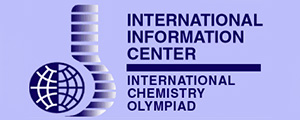Competition problems
Not less than 362 theoretical and 125 practical problems were set in the IChO competition during the first fifty years of its existence. The competition problems are gathered in the following four volumes of the collection “The competition problems from the International Chemistry Olympiads”:
VOLUME 1 – IChO 01-20
The competition problems from the International Chemistry Olympiads, 1st – 20th IChO, 1968 – 1988 (IUVENTA, Bratislava, 2008), pp. 1 – 405.
VOLUME 2 – IChO 21-40
The competition problems from the International Chemistry Olympiads, 21st – 40th IChO, 1989 – 2008 (IUVENTA, Bratislava, 2009), pp. 406 – 1139.
VOLUME 3 – IChO 41-45
The competition problems from the International Chemistry Olympiads, 41st – 45th IChO, 2009 – 2013 (IUVENTA, Bratislava, 2013), pp. 1140 – 1424.
VOLUME 4 – IChO 46-50
The competition problems from the International Chemistry Olympiads, 46th – 50th IChO, 2014 – 2018 (IUVENTA, Bratislava, 2019), pp. 1425 – 1759.
When composing the collection some difficulties occurred because the aim was not only to make use of past recordings but also to give them such a form that they may be used in practice and further chemical education.
Consequently, it was necessary to make some corrections in order to unify the form of the problems. However, they did not concern the contents and language of the problems. Many of the first problems were published separately in various national journals, in different languages and they were hard to obtain. Some of them had to be translated into English. Most of the xerox copies of the problems could not be used directly and many texts, schemes and pictures had to be re-written and created again. The changes concern in particular solutions of the problems set in the first years of the IChO competition that were often available in a brief form and necessary extent only, just for the needs of members of the International Jury. Some practical problems, in which experimental results and relatively simply calculations are required, have not been accompanied with their solutions. Re-calculations of the solutions were made in some special cases only when the numeric results in the original solutions showed to be obviously not correct. Although the numbers of significant figures in the results of several solutions do not obey the criteria generally accepted, they were left without change.
In this publication SI quantities and units are used and a more modern method of chemical calculations is introduced. Only some exceptions have been made when, in an effort to preserve the original text, the quantities and units have been used that are not SI. Although the numbers of significant figures in the results of some solutions do not obey the criteria generally accepted, they were left without change.
The authors of the original tasks were the members of the scientific committee of the organizing country but, unfortunately, the names of the authors of the particular
competition problems are not known and due to the procedure of the creation of the IChO competition problems, it is impossible to assign any author’s name to a particular problem. Nevertheless, responsibility for the scientific content and language of the problems lies exclusively with the organizers of the particular International Chemistry Olympiads.
There were some problems with the presentation of the solutions of practical tasks because most of the relatively simple calculations were based on the experimental results of contestants. Moreover, the practical problems in the last years are accompanied with answer sheets and several additional questions and tasks have appeared in them that were not a part of the text of the original experimental problems.
Consequently, it was necessary to make some corrections in order to unify the form of the problems (numbering of the tasks in the particular problems, solution inserted immediately after the text of the problem, solutions without grading points and special graphs used for grading of practical problems). Nevertheless, the mentioned corrections and changes do not concern the contents and language of the competition problems.
The practical problems set in the IChO competitions, contain as a rule some instructions, list of apparatuses available, chemicals on each desk and those available in the laboratory, and the risk and safety phrases with regard to the chemicals used. All of these items are important for the competitors during the competition but less important for those who are going to read the competition tasks of this collection and thus, they are omitted. Some parts of the solutions of practical problems are also left out since they require the experimental data which could be obtained by experiments during the practical part of the IChO competition.
It is obvious that the tasks should serve to both competitors and their teachers as a source of further ideas in their preparation for this difficult competition. For those who have taken part in some of these International Chemistry Olympiads the collection of the problems could be of help as archival and documentary material.
In the elaboration of this collection the editor had to face certain difficulties because the aim was not only to make use of past recordings but also to give them such a form that they may be used in practice and further chemical education.
Unfortunately, the authors of the particular competition problems are not known and due to the procedure of creation of the IChO competition problems, it is impossible to assign any author’s name to a particular problem. Nevertheless, responsibility for the scientific content and language of the problems lies exclusively with the organizers of the particular International Chemistry Olympiads. both competitors and their teachers as a source of further ideas in their preparation for this difficult competition. For those who have taken part in some of these International Chemistry Olympiads the collection of the problems could be of help as archival and documentary material.
Compiled and edited by A. Sirota (IChO Intern. Information Centre)


